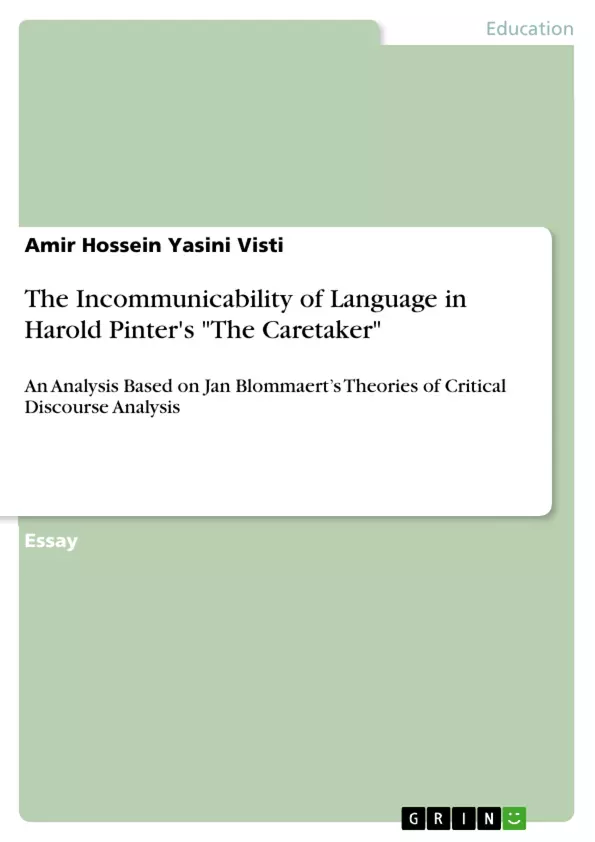The Caretaker (1960) by Harold Pinter, as a successful play in the twentieth century, reflects the incommunicability of language. In fact, Pinter has depicted the failure of communication, implying that language is at the verge of crisis.
In order to analyze the elements that play role in revealing the non-essential quality of language, Jan Blommaert’s Critical Discourse Analysis that describes the mechanism through which language and linguistic patterns act in social system can be helpful and efficient. This efficiency lies in investigating the common grounds of language and social studies. In the play, the incommunicability of language is drawn by the inequality the characters are involved with, the choice they have in using the language, the archive they use when choosing their language as the representative of determination. Furthermore, the personages have different voices in the work. The function of voice is controlling discourse. The voices that the characters employ in the play are directly related to their inequality formed in social system and to their identity constructed in it.
Speaking of identity, it is accounted the major concept for which the figures, consciously or unconsciously, struggle. Identities are formed through interactions and can be subjected to change by switching from one discourse to another. Generally speaking, the present paper intends to unveil the incommunicability of language in The Caretaker by Harold Pinter through studying some of the devices of the CDA as explained by Jan Blommaert.
Inhaltsverzeichnis (Table of Contents)
- I. Introduction
- II. Methodology
- III. Discussion.
- IV. Result.....
Zielsetzung und Themenschwerpunkte (Objectives and Key Themes)
This paper aims to investigate the incommunicability of language in Harold Pinter's play *The Caretaker* through the lens of Jan Blommaert's Critical Discourse Analysis (CDA). It seeks to understand how language functions as a tool for expressing identity, inequality, and power dynamics within the play.
- The role of language in constructing and challenging identity
- The relationship between language and social inequality
- The impact of choice and determination on language use
- The function of voice in controlling discourse
- The significance of the archive in shaping language use
Zusammenfassung der Kapitel (Chapter Summaries)
- I. Introduction: This chapter introduces the play *The Caretaker* by Harold Pinter and its depiction of challenged identity through the interactions of three characters: Aston, Mick, and Davies. It highlights the play's unconventional plot structure and the failure of communication between the characters. The chapter sets the stage for the subsequent analysis of language in the play.
- II. Methodology: This chapter delves into the theoretical framework of Critical Discourse Analysis (CDA) as presented by Jan Blommaert. It explores key concepts within CDA, including the social and communicative nature of language, the construction of meaning, and the role of inequality, choice, and determination in language use. The chapter also introduces the concept of “voice” and its significance in shaping discourse.
- III. Discussion: This chapter begins the analysis of *The Caretaker* through the lens of CDA. It examines how the play showcases the failure of language to communicate effectively, focusing on the characters' inability to connect despite their attempts to engage in conversation. The chapter explores the interplay between language, identity, and power dynamics within the play, highlighting the limitations of language in representing meaning and reality.
Schlüsselwörter (Keywords)
The primary keywords and themes explored in this paper include Harold Pinter, The Caretaker, Jan Blommaert, Critical Discourse Analysis, inequality, choice, determination, voice, identity, and social system. These concepts provide a framework for understanding the incommunicability of language within the context of the play.
- Quote paper
- Amir Hossein Yasini Visti (Author), 2014, The Incommunicability of Language in Harold Pinter's "The Caretaker", Munich, GRIN Verlag, https://www.hausarbeiten.de/document/384245


